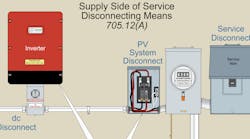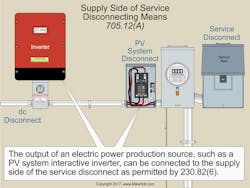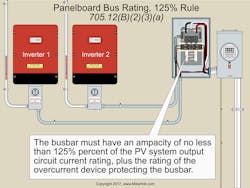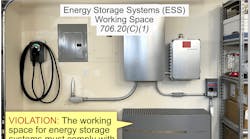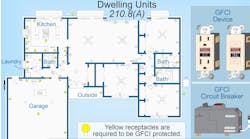Article 705 covers the connection of electric power sources that operate in parallel with a primary source. Typically, the primary source is the electric utility, but it can be an on-site source instead. To understand the requirements of Art. 705, you must be familiar with key terms it uses (see Definitions sidebar below).
All equipment must be approved for the intended use [Sec. 705.6]. Interactive inverters, engine generators, and energy storage equipment that are to be connected in parallel with electric utility power must be listed or field labeled for the intended use of interconnection service.
Only qualified persons (as defined by Art. 100) may install electrical power production sources operating in parallel with a primary power supply (i.e., electric utility interconnection) [Sec. 705.8].
Directory
A permanent plaque or directory denoting the location of all electric power source disconnecting means must be installed at service equipment and photovoltaic (PV) system disconnecting means [Sec. 705.10]. The plaque or directory must be permanently affixed and have sufficient durability to withstand the environment involved [Sec. 110.21(B)].
Exception: Installations with many power production sources may be designated by groups.
Supply-side connection
If you’re connecting the system interactive inverter output circuit conductors on the supply side, then you must meet two requirements [Sec. 705.12(A)]:
1. Comply with Sec. 230.82(6) (Fig. 1).
2. Ensure the sum of the ratings of all overcurrent protection devices (OCPDs) does not exceed the ampere rating of the electric utility service.
When determining the number of disconnects per service per Sec. 230.71(A), the PV disconnect(s) connected on the supply side of service equipment isn’t counted. That’s because it’s not a service disconnect as defined in Art. 100.
Load-side connection
If you’re connecting the system interactive inverter output circuit conductors on the load side, the NEC requirements are more complicated. For starters, the PV system circuit conductors must terminate to a dedicated circuit breaker or fusible disconnecting means
[Sec. 705.12(B)(1)].
Where the PV system connection is made to a feeder, that portion of the feeder on the load side of the power source output connection must be protected by one of the following:
• The feeder has an ampacity equal to or greater than the feeder protection device rating plus 125% of the PV system rated output circuit current [Sec. 705.12(B)(2)(1)(a)].
• An overcurrent device on the load side of the PV system connection doesn’t exceed the ampacity of the feeder [Sec. 705.12(B)(2)(1)(b)].
In systems where the power source output connections are made at feeders, any taps must be sized based on the sum of 125% of the power source(s) output circuit current and the rating of the overcurrent device protecting the feeder conductors per Sec. 240.21(B) [Sec. 705.12(B)(2)(2)].
PV system feeder taps not longer than:
• 10 ft must have an ampacity not less than ten% of the sum of the feeder protection device plus 125% of the PV system rated output circuit current [Sec. 240.21(B)(1)].
• 25 ft (but longer than 10 ft) must have an ampacity not less than 33% of the sum of the feeder protection device plus 125% of the PV system rated output circuit current [Sec. 240.21(B)(2)].
But in no case can the ampacity of the feeder tap (regardless of length) be less than the rating of the terminating OCPD [Sec. 240.21(B)(1)].
Bus bar ratings must have an ampacity determined by one of the following methods [Sec. 705.12(B)(2)(3)]:
(a) 125% rule. The bus bar must have an ampacity of no less than 125% of the PV system output circuit current rating, plus the rating of the OCPD protecting the bus bar (Fig. 2).
(b) 120% rule. Where the PV system OCPD is at the opposite end of the feeder conductor termination, the sum of 125% of the PV system output circuit current rating, plus the rating of the OCPD protecting the bus bar must not exceed 120% of the bus bar ampacity.
(c) 100% rule. The sum of the ampere ratings of all OCPDs on the bus bar must not exceed the ampacity of the bus bar.
(d) Center-fed panelboard in dwellings. The sum of 125% of the PV system output circuit current rating, plus the rating of the OCPD protecting the bus bar must not exceed 120% of the bus bar ampacity.
Panelboards containing PV AC inverter circuit breakers must be field marked to indicate the presence of all sources of all power [Sec. 705.12(B)(3)] (Fig. 3).
Circuit breakers that aren’t marked “Line” and “Load” can be backfed [Sec. 705.12(B)(4)].
Informational Note: Fused disconnects are suitable for backfeed applications, unless otherwise marked.
Backfed circuit breakers for interactive inverter circuits aren’t required to be secured in place by an additional fastener as required by Sec. 408.36(D) [Sec. 705.12(B)(5)].
PV AC inverter circuit breakers aren’t required to be fastened in place because the PV interactive inverter automatically ceases to export AC current from the inverter when the breaker is removed.
OCDP location
Supply-side conductor connections for PV systems must terminate in an OCPD that’s within 10 ft of the point of interconnection to the electric utility [Sec. 705.31].
Loss of electric utility power
Upon loss of electric utility power, the inverter AC output circuit must automatically disconnect from the electric utility power source and not reconnect until electric utility power has been restored [Sec. 705.40].
Exception: A listed interactive inverter may automatically cease exporting power upon loss of electric utility power and resume exporting power once electric utility power has been restored.
Interactive inverters
Single-phase inverters connected to a 3-phase electric utility power source must not increase electric utility unbalanced system voltage at the service to more than 3% [Sec. 705.100(A)]. An example of an unbalanced interconnection would be connecting two single-phase inverters to a 3-phase system.
See ANSI/C84.1, Electric Power Systems and Equipment — Voltage Ratings (60 Hz). ANSI C84.1 recommends that “electric supply systems should be designed to limit the maximum voltage unbalance to 3% when measured at the electric-utility revenue meter under no-load conditions.” Improperly connecting single-phase inverters to a three-phase system can result in a significant increase in unbalanced system voltage.
The formula to determine maximum unbalanced voltage is:
Maximum Unbalanced Voltage = 100 × Maximum Deviation from Average Voltage ÷ Average Voltage.
Example 1: If we connect two single-phase PV systems to lines B – C and this causes the B – C voltage to increase from 200V to 202V because of a decrease in loading, the maximum unbalanced system voltage for the following line voltages: A – B 206V, B – C 201V, and A – C 204V will be _____%.
Solution:
Maximum Unbalanced Voltage = Maximum Deviation Volts from Average Voltage ÷ Average Voltage × 100 (for percent)
Average Voltage = (206V + 202V + 204V) ÷ 3 lines = 204V
Maximum Deviation from Average = 206V – 204 = 2V
Maximum Unbalanced Voltage = 2V ÷ 204V × 100 = 1%
Answer: 1%
Example 2: If we connect two single-phase PV systems to lines B – C and this results in B – C voltage to rise from 200V to 201V because of a decrease in loading, the maximum unbalanced system voltage for the following line voltages: A – B 206V, B – C 201V, and A – C 204V will be _____%.
Solution:
Maximum Unbalanced Voltage = Maximum Deviation from Average Voltage ÷ Average Voltage × 100 (for percent)
Average Voltage = (206V + 201V + 204V) ÷ 3 lines = 203.66V
Maximum Deviation from Average = 206V – 203.66V = 2.34V
Maximum Unbalanced Voltage = 2.34V ÷ 203.66V × 100 = 1.15%
Answer: 1.15%
Plan carefully
When interactive electrical power production sources such as wind powered generators, solar PV systems, or fuel cells are present, there usually isn’t a transfer switch. In fact, multiple sources of electrical supply are often connected simultaneously.
To ensure parallel power sources play nice with each other and the system is safe, you must plan carefully and work methodically. Start by looking at whether, for a particular installation, it makes more sense to connect the output of the interconnected power source to the supply side or the load side.
Holt is the owner of Mike Holt Enterprises, Inc. in Leesburg, Fla. He can be reached at www.mikeholt.com.
SIDEBAR: Definitions [Sec. 705.2]
Interactive inverter output circuit ― The conductors between the photovoltaic (PV) interactive inverter and the service equipment or another electric power production source, such as an electric utility, for an electrical production and distribution network.
Multimode inverter ― Equipment having the capabilities of both the interactive inverter and the standalone inverter.
Power production equipment ― The generating source, and all distribution equipment associated with it, that generates electricity from a source other than an electric utility supplied service.
